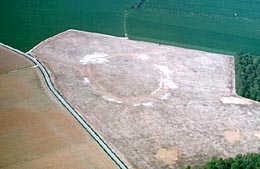- Home
- Clues on the ground
- Pitfalls and confusions
- Avoiding the pitfalls
In many cases, simple comparing photographs taken at intervals helps us to avoid a number of traps — the placement of haystacks, manure piles, sheep pens, horse rings, watering circles, feeding troughs for cattle, etc.
In fact, these troughs, once they are removed, leave rectangular marks that are similar to inhumation burial sites, spread out across fields, and sometimes placed in a row. Sometimes, the time and the way in which a site is razed can introduce confusion, like at Montigny. On a single, isolated photo, a dark patch on bare ground can appear to be the trace of a vanished dwelling, but it's just the shadow of a cloud! At each flyover, it is important to take a number of pictures and to take them each season.
Compare these photographs, and build up site files. In this way, almost all possible errors can be eliminated.
The site was leveled by a bulldozer. One would think that it was a recent vestige, when in fact only the destruction is modern…Montigny (Oise).
Same site, a few years earlier. The medieval-era oval earth levee is readily visible.


